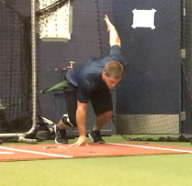In part 1 of the 60 yard dash training series (you can find it here) I talked about how your training will not always lead directly to success. I talked about several months of speed training that I had been doing and attempted to explain the roller coaster athletes are put on when training for their sport. In part 2, I will write a follow up and talk about the past month of training and the results it lead to.
My training schedule this past month was fairly similar to the past, but with two new exercises instituted to take the place of the cone drill from the past. This is what my sprinting schedule looked like:
*NOTE: if an exercise is not described here it was described in part 1. A description can be found there. Part 1
Day 1:
-General warm-up
-Running specific warmup (high knees, skips, etc)
-Falling cone accelerations, 4 reps
-Banded accelerations superset with tennis ball accelerations, 4 reps
The purpose of the superset was to find a way to overload the first 10 yards of the sprint with the band so when I went to do the tennis ball accelerations, my body would produce more force. This has been termed contrast training in the past. You load up an exercise and superset it with a more dynamic exercise in the hopes that the extra load will improve the movement you are working on when that extra load is taken away.
Banded accelerations demo:
-11 yard accelerations with visual timing trigger, 2 reps
(visual timing trigger just means I came up with a way to make it more gamelike, as the season is approaching for me. I set up a shirt on the ground and would throw a tennis ball in the air so that it might land on the shirt. If it landed on the shirt, I didn’t go and treated it like a pickoff. If it didn’t land on the shirt I treated it as the pitcher delivering home and went)
-Flying 30’s, 4 reps
Day 2:
-General warm-up
-Sprint specific warm-up
-Falling cone accelerations, 4 reps
-Shuttle run with tennis balls, 4 reps
-Lateral cone chop to sprint with tennis ball, 4 reps
I thought of this day as a lateral day. Whereas the other days I am working on straight line speed, on this day my focus is on changing directions and moving quickly in tight spaces.
Day 3:
-General warmup
-Sprint specific warmup
-Falling cone accelerations, 4 reps
-Sled drags superset with tennis ball accelerations, 4 reps
Sled drags demo:
-11 yard acceleration with timing trigger, 2 reps
-Flying 30’s, 4 reps
Whereas in day 1 I used bands, I used a sled on this day. The sled allows you to cover a little more distance whereas the band forces you to focus on your first 3 steps or so. The goal is still the same. We want to overload the first 3-5 steps with an external load so when we take that away, we are faster and able to produce more force.
My lifting over this time period stayed pretty much the same. Instead of doing the 1 legged jump and lands in my deadlift superset, I did a 1 legged depth jump with a lower box. Everything else stayed the same.
As I said in the previous article, my previous PR on the 60 was a 6.84. The month before the plan above I ran a 7.0. After doing the above training for 3 weeks, I ran a 6.88.
I was slightly disappointed by that time, however, I got it going back in the right direction. For me, trying to intentionally create longer strides doesn’t transfer very well when it comes time to test. I need a method that does the same thing but does not require me to think about it. For instance, when testing this time all that was on my mind was to “stay loose and be in rhythm”. I think an important part of being a coach is making it as simple as possible for the athlete when it comes time to complete. Sure, you can take the time to explain your methods and tell them why you are having them do what they are doing. I actually think that can be a great way to get buy in from the athlete. At the same time, we also need to simplify it as much as possible for competition, because that will allow the athlete to take the focus away from himself and put it somewhere else, where it needs to be.
I hope this two part series helped you get a better grasp on what it means to actually train and to deal with the successes and failures that come from that. Your progress will never be linear, no matter how hard or smart you think you are working. It is important to understand that and to maintain a long term focus instead of getting caught up in all the day to day happenings. The more you let a single performance affect you, whether that performance be good or bad, the more it will impact how you go about your business in the future. Don’t let it affect you. Be the same all the time, no matter the results you are getting. Become less romantic about your training. Don’t live and die by your numbers. Take them one at a time and understand they are simply points along the way on a path you are carving out for yourself. Use them to guide you, but don’t let them define you.
That is all for now in the 60 yard dash training series, as the season is coming up and I will be in maintenance mode. I may continue this series in the winter, and will update it if I find a method that works particularly well.
I hope you enjoyed. Questions or comments? Leave them below or shoot me an email at brady@dacbaseball.com.
